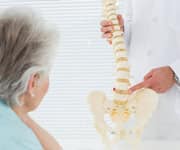Life Extension Magazine®

Dr. Jonathan Ozner is a board-certified chiropractic physician, a certified personal trainer, a Life Extension® member, and the clinical director at Broward Health and Rehab in Sunrise, Florida. Most recently, Dr. Ozner co-authored a study on the benefit of chiropractic treatment on trigeminal and glossopharyngeal neuralgia, which was published in the Journal of Upper Cervical Chiropractic Research.
Very active in sports as well the fitness and health communities—and with a passion for nutrition and proper supplementation—Dr. Ozner truly practices what he preaches and lives a healthy, holistic lifestyle. We recently met with him at his clinic to ask about the broad range of health problems now being treated by modern chiropractic’s latest diagnostic and therapeutic techniques.
LE: Most people understand that chiropractic treatment focuses on correcting spinal misalignments that can, over time, lead to dysfunction and a variety of diseases. What are the origins of these misalignments in the first place?
JO: A “vertebral subluxation” is misalignment of a vertebra—or spinal misalignment—that puts pressure on the nerve root corresponding to that segment, affecting the neuronal impulse. Every body aspect is directly controlled by the nervous system and subluxations can result from chemical, physical, and especially, emotional stress. [If left] uncorrected, health issues arise. Research shows that 80 to 90% of subluxations go undetected, as we usually don’t “feel anything.” Many patients first turn to chiropractic care to resolve back and neck pain and headaches. But pain—usually the last thing to manifest from a subluxation—is the body’s way of saying: “Emergency! There’s a major problem that’s been occurring for quite some time now.”
LE: What are the specific benefits of correcting subluxations?
JO: Treating subluxations can provide reduced stress, anxiety, and fatigue, allergy resolution, and improved sleep and gastrointestinal function. When the spine is aligned, we’re healthy. When it’s not, and it puts pressure on nerves, we’re in a dysfunctional state.
LE: Modern chiropractic education involves a number of new types of training and methods. Can you explain how training has expanded to include nutrition, oncology, or cardiology education?
JO: Chiropractic education includes the same classroom hours as medical school. While classes such as nutrition, pathology, microbiology, and biochemistry are taught, there’s a strong emphasis on anatomy and physiology, spinal biomechanics, and radiology, as well as chiropractic-specific adjusting technique.
LE: Chiropractors are evolving to become more “holistic.” Can you elaborate?
JO: Chiropractors deal with the entire function of the body as it relates to the health of the spine and nervous system. The profession is ever-evolving as emerging research explains scientifically what we’ve known to be true for 100 years. One recently published study dealt with the wellness aspect of chiropractic. This study looked at the retention rate of addiction patients. Patients who received chiropractic care via a technique called “torque release” had the best results by a significant margin. Another long-term seven-year study, which yielded incredible results, showed that patients under regular chiropractic care experienced 60% fewer hospital admissions, 59% fewer days in the hospital, 62% fewer outpatient surgeries, and 85% reduced pharmaceutical costs!
LE: Spinal degeneration can develop with age, limiting mobility and causing pain and headaches. How does it occur, what conditions can it cause, and how can it be treated?
JO: We’re constantly putting our bodies through stressors—physical, chemical, and emotional. Eventually, this causes body wear and tear, notably in the spine. Distorted biomechanics and movement patterns, as well as a sedentary lifestyle, cause alterations in the joint stability in the spine itself. Attempting to stabilize these joints, the body deposits calcium there, furthering joint immobilization and degeneration. We see “osteophytic formations”—bony spurs that eventually impede the spinal cord and nerves, causing health issues. Each spinal segment—consisting of vertebral bodies, intervertebral discs, and surrounding muscles and ligaments—gets its nutrition via spinal movement itself. Movement diffuses nutrients into the discs, keeping them hydrated and well-maintained. At least 30 minutes daily exercise and sufficient water intake can have profound, positive effects on spine health, and thus, the body.
LE: If spinal degeneration has already caused calcium deposits and bone spurs, is it too late to reverse?
JO: Chiropractic adjustments break up adhesions—many due to calcium deposits—and increase mobility in subluxated spinal segments. This relieves pressure on the exiting spinal nerve, reducing stress and irritation body-wide. It only takes the pressure of a dime on a spinal nerve to diminish nerve impulse. Correcting these minor misalignments can have a major impact on overall health and well-being.
LE: There has been research into chiropractic’s capacity to address difficult-to-treat conditions such as Ménière’s disease, tinnitus, and even hypertension. Can you please elaborate?
JO: In essence, we don’t actually “treat” anything. However, by analyzing the patient for vertebral subluxations and correcting them, we restore the body to a homeostatic state or “balance out” the nervous system, and many health issues then resolve naturally. Conditions such as Ménière’s, tinnitus, and high blood pressure have been seen to normalize under chiropractic care. Ménière’s is an inner-ear disorder that affects hearing and balance. The vestibular nerve, a cranial nerve, plays a role in balance and coordination of the inner ear. The brainstem, sitting within the “foramen magnum of the atlas”—or C1 vertebra—directly links to all cranial nerves, including the vestibular nerve. When we see a subluxation in the atlas [the first vertebra, which supports the head] putting pressure on the brainstem, this can profoundly affect function of the vestibular nerve, ultimately serving to cause inner-ear dysfunction, which can include tinnitus, vertigo, and hearing loss—the triad known as Ménière’s disease. As for blood pressure, the lumen [channel] of the blood vessels is directly controlled by the sympathetic nervous system. Taking pressure off the spinal cord and nerves can reduce the sympathetic response on the blood vessel itself, decreasing vasoconstriction and increasing vasodilation, ultimately improving blood pressure.

LE: Aside from the spine—accidents or sports injuries frequently damage muscles and joints throughout the body. Does such damage fall within chiropractic’s sphere?
JO: Car accidents and sports injuries significantly impact not only the spine, but also surrounding muscles and ligaments. Chiropractors are licensed in physiotherapy, which includes soft-tissue mobilization therapy and prescribing exercises that strengthen weak muscles and stretch hypertonic muscles and ligaments. Also, deep-tissue laser therapy is an exciting, new therapy that works by what’s called “photo-bio-modulation.” Most soft-tissue injuries involve extensive inflammation and edema. The deep-tissue laser sends photon light energy into the damaged tissue cell, helping repair mitochondria and restore cell functionality. This increases ATP and vasodilation and decreases the injury’s inflammatory response. We’ve seen some incredible results in patients suffering from arthritis, tendonitis, neuropathy, and other conditions. Within a few treatments, patients report decreased or eliminated pain and increased range of motion. And deep-tissue laser therapy is completely noninvasive, backed by controlled trials, and costs significantly less than surgery. We provide this therapy for soft tissue injuries, in addition to chiropractic care.
LE: Modern chiropractic utilizes broader techniques than manual manipulation of vertebrae. Can you provide an example?
JO: While there is nothing wrong with the manual adjustment, an innovative technique called torque release deals with the entire spine as one unit and looks at specific segments of direct dural/meningeal [membranes surrounding the spine] attachment, which ultimately control alignment and function of the spine and body.
LE: Tell us about chiropractic’s modern diagnostic techniques.
JO: Chiropractic will always use traditional radiographic images to evaluate osseous [bone] issues, MRI to evaluate soft tissue pathology, and paraspinal thermography, which detects patterns of heat [adjacent to the spine] and gives us a “window in” as to where their vertebral subluxation may exist. It’s a great tool to show patients that they have an inflammatory response at a given segment in their spine.
LE: What role does corrective exercise play in modern chiropractic?
JO: We know most people are walking around with hypertonicity [high pressure] of some sort, distorting overall posture and affecting health. When we have muscle spasms and hypertonic muscles and ligaments, we create weak muscles on the opposite side, creating an imbalance in the body. This can put the spine out of alignment as ligaments and muscles with direct attachments become taut, and we begin developing nerve pressure. This snowball effect can be avoided by performing daily stretches and exercises. We arrange programs tailored to address these areas.
LE: Can you explain how nutrition supports modern chiropractic?
JO: I make sure my patients supplement with a good multivitamin, such as Life Extension® brand, especially one providing adequate vitamins D3, A, and C. We know that inflammation contributes significantly to disease. I [tell] patients to take a supplement such Life Extension®’s Super Omega-3—I use it myself—which enhances joint function, including that of the spinal column. For patients who are athletes or those who don’t get adequate protein, I recommend quality protein powder. The Life Extension® brand is terrific, because it doesn’t contain BGH, and it’s all natural—zero artificial colors or sweeteners, which have been linked to adverse health issues.

LE: Should individuals undergo regular chiropractic testing to prevent disorders? And how frequently?
JO: Whether in pain or not, getting checked regularly by a doctor of chiropractic can help prevent future health issues. Many patients come into my practice in pain and after their care plan, get amazing results. An initial care plan may include several visits per week depending on the condition, and we reduce those visits as needed until a stage of maintenance is achieved. When out of pain, I recommend patients come in on a wellness basis to ensure they’ll function at their highest potential. It’s like taking your car in for maintenance—you wouldn’t wait until the car breaks down! We should have routine follow up visits to ensure we’re in proper alignment. You wouldn’t put junk fuel into your car, so you should eat the right types of foods. And lastly, if you never drove your car, it would eventually break down—we need light-to-moderate exercise at least 30 minutes daily so we don’t break down! By utilizing exercise, nutrition, supplementation, positive mental outlook, and most important, chiropractic care, patients report back to me with amazing results in their overall health and well-being!
LE: Thank you, Dr. Ozner.
JO: Thank you.
Readers interested in learning more about chiropractic and about Dr. Ozner’s work can visit his clinic website at http://www.browardhealthandrehab.com. To book an appointment with Dr. Ozner, readers can reach his office at 1-954-748-3700.
If you have any questions on the scientific content of this article, please call a Life Extension® Health Advisor at 1-866-864-3027.

